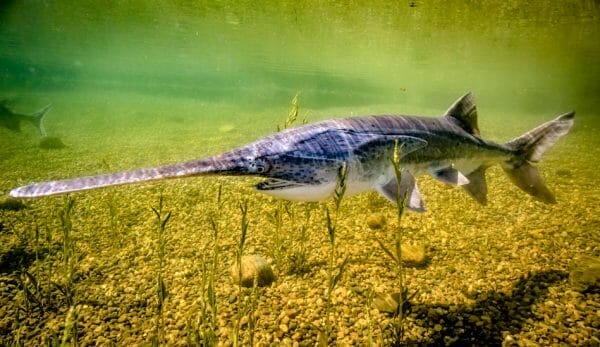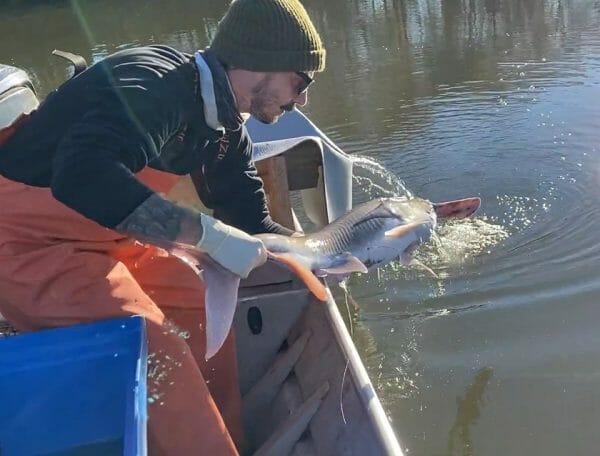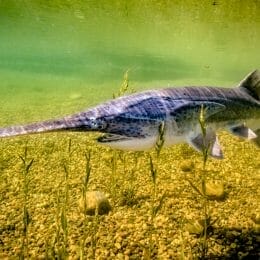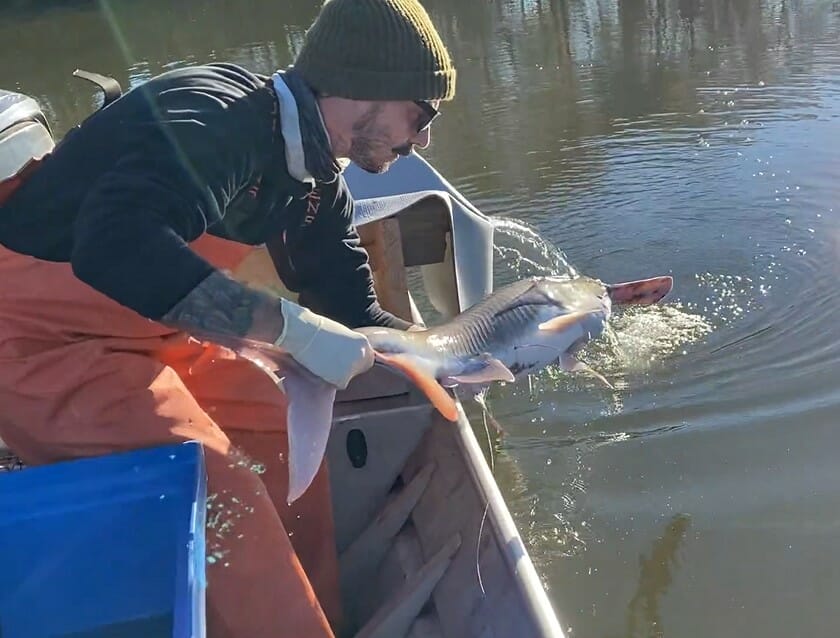American Paddlefish
The American paddlefish (Polyodon spathula), also known as the spoonbill catfish, is an ancient species, with fossils dating back to around 125 million years ago. They exist exclusively within the Mississippi and Mobile River basins and coastal drainages in Louisiana and in Alabama, where their historic range has shrunk considerably and are now considered vulnerable in many places.
 American Paddlefish
The American paddlefish was first scientifically described in 1774 by French naturalist P. J. É. Mauduyt de la Varenne, who was given a sample collected from Louisiana. The genus name translates from the Greek as “many toothed” because the original specimen was a juvenile that had many small teeth (a feature they do not retain in adulthood). European residents along the Mississippi River called the fish spatule because the snout resembled the tool used by pharmacists, hence the species name spathula. Paddlefish were initially believed to be a type of shark, but they are actually in the order Acipenseriformes with sturgeons. The American paddlefish is now the only species of its kind remaining, as the Chinese paddlefish became extinct between 2005 and 2010 as a result of overfishing and habitat fragmentation from dam construction.
American Paddlefish
The American paddlefish was first scientifically described in 1774 by French naturalist P. J. É. Mauduyt de la Varenne, who was given a sample collected from Louisiana. The genus name translates from the Greek as “many toothed” because the original specimen was a juvenile that had many small teeth (a feature they do not retain in adulthood). European residents along the Mississippi River called the fish spatule because the snout resembled the tool used by pharmacists, hence the species name spathula. Paddlefish were initially believed to be a type of shark, but they are actually in the order Acipenseriformes with sturgeons. The American paddlefish is now the only species of its kind remaining, as the Chinese paddlefish became extinct between 2005 and 2010 as a result of overfishing and habitat fragmentation from dam construction.
Paddlefish are unique in appearance, with smooth skin, small eyes at the base of their snout, long tapering opercula (gill-covering structures), a forked tail, large mouth, and a long flat snout (or rostrum) that resembles a paddle. The snout is about one-third of their total body length and is why they have their common name. They have blue-grey skin along their back and a white stomach and can grow up to 5 feet (~1.5 meters) in length. In Alabama, male paddlefish weigh around 22 pounds (~10 kilograms), and female paddlefish are around 31 pounds (~14 kilograms) (this varies depending on the river), but the last study that reported average weight was from the late 1990s, shortly after intense commercial overfishing. The state record paddlefish is just over 52 pounds (~23.5 kilograms), but fishing for paddlefish is prohibited in Alabama. Paddlefish have been known to live up to 18 years in the wild, and females are typically larger than males.
In Alabama, male paddlefish become sexually mature at around five years of age, and females at six years old. Paddlefish make long-distance upstream migrations from January through March from the Gulf to spawning habitats in waters of the Alabama and Tombigbee Rivers, and possibly their tributaries. Paddlefish spawning sites have not yet been identified in Alabama. During spawning migrations, paddlefish have been observed congregating in the tailraces at the base of dams, likely because dams block their migration routes. In Alabama, special lock operations were added to dams in attempt to help fish overcome them during migration seasons, but they do not appear to have been successful. Dams in the state lack any other type of structure that could help fish pass over them. Biologists believe that increasing water temperature and increased water current from spring rain cue paddlefish to start these migrations. In Alabama, spawning migrations as far as 193 miles have been documented, but the longest recorded migration was 1,180 miles. They also typically return to the same spawning sites each time they spawn. In Alabama, Paddlefish are native to the Tennessee, Mobile-Tensaw, Tombigbee, Black Warrior, Alabama, Cahaba, Coosa, and Tallapoosa basins, but they are now thought to only exist below the fall line in the Mobile-Tensaw, Tombigbee, Alabama, Cahaba basins, and the lower stretches of the Tallapoosa, Cahaba, and Black Warrior Rivers.
Paddlefish spawning behavior has never been observed, but in April through May females lay small dark brown or greyish eggs on gravel or rocky river bottoms. A single female paddlefish can lay hundreds of thousands of eggs when spawning. These eggs need fast-moving water, which provides oxygen and keeps the eggs clear of sediment to successfully hatch. Males can spawn every one or two years, whereas females can only spawn every two or three years. Larval paddlefish are less than half an inch when they hatch and retain a yolk sack that they use for nourishment until they become large enough to feed on their own.
When paddlefish conclude spawning, they return downstream, where they spend much of their summer in slow-moving backwater habitat that typically contains more of their preferred food items. Their long snout acts as an antenna for sensing small zooplankton and insect larvae, which are their primary food sources. They eat these tiny, insect-like organisms by swimming through the water with their mouth open, filtering them out of the water using their long gills. Small fish have been found in their stomachs, but they were likely accidentally consumed. Slow-moving waters connected to the main river channel, like backwater habitat and oxbow lakes, are also believed to be important nursery habitats for young paddlefish. Like sharks, paddlefish do not have a swim bladder, which means they have to swim continuously to avoid sinking. Their long rostrum helps with this by acting as a rudder that helps them control where they are swimming. Paddlefish have adapted well to lake environments in many states. Paddlefish can be observed jumping out of the water at times, especially early in the morning and late in the evening, a spectacular sight given their size.
Paddlefish have been introduced in several European countries and China for aquaculture and recreation but cannot sustainably reproduce there, so they need to be stocked. In the United States, paddlefish occur natively in Alabama, Arkansas, Iowa, Illinois, Indiana, Kansas, Kentucky, Louisiana, Minnesota, Missouri, Mississippi, Montana, North Dakota, Nebraska, Ohio, Oklahoma, South Dakota, Tennessee, Texas, Virginia, Wisconsin, and West Virginia. They are now extirpated (no longer exist) in Maryland, New York, North Carolina, and Pennsylvania.
The most significant threats to paddlefish survival are habitat degradation and overexploitation. Paddlefish are prized for their eggs for caviar, and a single fish can be worth between $250 and $700. Overexploitation is especially problematic for paddlefish because of their slow maturity and periodic reproduction, which makes it important to protect older fish. The building of dams has blocked paddlefish migrations and destroyed spawning habitat. Dams can also cause injury or even death to paddlefish that attempt to pass them. In many states where paddlefish populations are stable, they have become prized as a trophy species, and for their filets. Paddlefish tissues and eggs have been found to contain PCBs and other contaminants in polluted waters, so they can act as an indicator species for environmental health.
The Alabama Natural Heritage Program lists paddlefish as vulnerable, which means that they are rare or uncommon in the state and are at moderate risk of extirpation owing to its restricted range, relatively few remaining populations, and recent and widespread declines, among other factors. The International Union for Conservation of Nature also lists paddlefish as being vulnerable. A commercial fishery for paddlefish was re-opened in Alabama from 2013 to 2018, but the fishery was closed again after commercial overharvest. A moratorium on fishing for paddlefish is currently in place.
Further Reading
- Boschung, Herbert T., and Richard L. Mayden. Fishes of Alabama. Washington, D.C.: Smithsonian Books, 2004.
- Dillard, Joe G., L. Kim Graham, and Thomas R. Russell, eds. The Paddlefish: Status, Management and Propagation. Special Publication No. 7. Columbia, Mo.: American Fisheries Society, North Central Division, 1986.
- Jennings, Cecil A., and Steven J. Zigler. “Ecology and Biology of Paddlefish in North America: Historical Perspectives, Management Approaches, and Research Priorities.” Reviews in Fish Biology and Fisheries 10 (June 2000): 167-181.
- Jennings, Cecil A., and Steven J. Zigler. “Biology and Life History of Paddlefish in North America: An Update.” In Paddlefish Management, Propagation, and Conservation in the 21st Century: Building from 20 years of Research and Management, edited by Craig P. Paukert and George D. Scholten, pp. 1-22. American Fisheries Society Symposium 66. Bethesda, Md.: American Fisheries Society, 2009.
- Schooley, Jason D., and Dennis L. Scarnecchia, eds. Paddlefish: Ecological, Aquacultural, and Regulatory Challenges of Managing a Global Resource. American Fisheries Society Symposium 88. Bethesda, Md.: American Fisheries Society, 2019.






